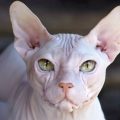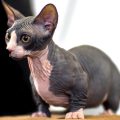The Peterbald Sphynx is a peaceful and noble breed. These cats never feel alone. They are very attached to their owner and will show affection towards other family members.
These cats are very friendly and intelligent. They make friends with adults as easily as the small ones of the family. As well, they are very friendly with other house pets, including dogs.

They differ from other cats as they have no fur. Hairless cats have been popular for many years. At first, these breeds were considered exotic, but nowadays, Sphynx owners know that this is a smart and very friendly pet.
Peterbald Breed Origins
The second name of this breed is Peterbald or Neva Sphynx. Cats were given this name as they were first bred in St. Petersburg. Olga Mironova was the Felinologist that brought them out.
Tatjana Komarova helped by being the owner of the male Sphynx. It was a Don Sphynx by the name of Anthenogen Myth. The mom of the kittens was an oriental cat named Radma Von Jagenhorf. As a result of mating, four kittens were born.
From the Don Sphynx, the Peterbalds received the gene of no hair and from the mother – gracefulness, a sharp shape of the head and long legs.
In 1996, the breed was registered, and in 2003, it was recognized by the World Cat Association.
Peterbald Breeds Description and Standards
Peterbalds can be compared to supermodels who walk along the catwalk, meaning they are graceful, refined and elegant animals.

Standards and main characters of the breed:
- The head of the animal is wedge-shaped. It is medium-sized and elongated. Cheeks are flat, nose is straight. Cat specialists call this profile the “Saiga profile.”
- The cat’s neck is thin and long like a swan’s neck.
- The ears of the Peterbald are large and up straight. Ears are wide at the base. They are a little to the side. In this regard, it seems that the cat is scared or alarmed.
- This breed of cat has a very beautiful body shape. The body is elegant, flexible and muscular. The shoulders, chest and hips are quite narrow. Representatives of the cat breed belong to medium-sized cats. The maximum weight of an adult male does not exceed 5 kg.
- Peterbalds have beautiful and slanting eyes. They are deep-set, and the outer corners of the eyes are stretched out. Eye colors can be green or bright blue. There are also Peterbalds with deep blue eyes.
- Petersburg Sphynx legs are long and thin. Because of their paws, these cats are compared with models. The front legs are crooked, which is considered a disadvantage to cats. The back legs are longer than the front. The foot itself is oval. The pads are thickened, and the fingers are thin and spread.
- The tail of the animal is thin, both at the base and at the tip, very long and very flexible.
- The skin of the Peterbald is fluid, it gathers in wrinkles on the body and the head, and it is pleasant to the touch. Kittens may have small fluffy fur, but after two years, cats become completely bald.
Types of coats
Peterbald cats can have a different colored skin coat.
There are nine coat types for Peterbald Sphynxes:
- Bald-born – such kittens are born bald. They are completely hairless at birth.
- Naked cat – becomes bold after two years of age.
- Flock is a cat whose hairs are rare and soft. The length of the hair does not exceed 2 mm. Such cats do not have whiskers and eyebrows.
- Velor – hair is located more densely compared to the flock.
- Brush – hair can have different degrees of density. Can have soft or hard fur.
- Brush point – a type when fur is present only on certain parts of the cats body: tail, paws and head.
- Flat coated – This is a cat that has flat fur.
- Dust – hair/fur so thin that it resembles dust.
- Rubber – Sphynx skin can be pulled like rubber, but it feels very pleasant.
As for the colors, for Peterbalds, this can be the most diverse.

Peterbald`s behaviour
The nature of the Peterbald is another advantage for the breed. Representatives of the breed are very friendly, peaceful and sociable.
Unlike many other cats, Sphynxes are not loners, and they like to spend time with their owner and other family members, but the owner is their favorite.
Peterbalds love the attention; therefore, if you wish to have a less needy pet, then don’t choose a Petersburg Sphynx.

These cats get along very well with other pets, not just cats. They can be dogs and birds. Peterbalds are also great for young children. In addition, animals are very playful, and a candy wrapper from sweets can be their entertainment for several hours.
By virtue of their nature, these pets are able to learn many commands and are also easily accustomed to the tray, scratching post and place to sleep.
Maintenance and care
The care of a Petersburg Sphynx is not that different from ordinary cat care. Specificity only consists of the care for the skin of the animal.
It is very important to know that Peterbalds let out grease from their skin that visually looks like lubricant or fat that some inexperienced pet owners take for sweat. But the grease’s function is to protect the cat’s skin from dryness and crackles.
As the cat does not have any eyelashes, you will often see them rub their eyes.
This also applies to the ears of the animal.
Washing a Peterbald should not exceed more than two times per week. These cats are very calm about water.
The Peterbald happily treats a sunbath in the summer period of the year, but beware, as it might get sunburn from excessive sunlight.
Nutrition
If the excrement of the pet is overabundant and has a brown color, then the Sphynx is not eating properly. In this case, you should change the diet of the cat.
Peterbalds are famous for their appetite and will eat anything that the owner will give it. Ideally, a mix of canned cat foods and organic foods are recommended.
Peterbald Health
Mostly, problems with health in this cat breed is non-existent. In general, Sphynxes have good health and are not common to have any type of disease.
But typical cat diseases are possible. Casually, Peterbalds get common colds, which is due to the lack of fur; therefore, they must be kept under conditions that exclude drafts, hypothermia and overheating.
All Sphynx cats can also suffer from acne and allergies. Allergies can be with a cat for all of his life or go away on its own.
Sometimes, animals die at birth from an underdeveloped thymus. Sick cats usually die at a very young age.
On average, Peterbalds live for 14 years.
How to choose a kitten
Firstly, make sure the kitten is at least three months old. Separation from the mother beforehand can damage the kitten’s psyche, which can badly impact the development and health of the animal.
Peterbald kittens are most suitable for responsible owners who will pay attention to the animal, monitor it and provide care for kittens and adult animals in the future.

Peterbalds require a lot of attention and affection. Most owners of these cats give all of their love to their beloved pets, afterward receiving more in return.



